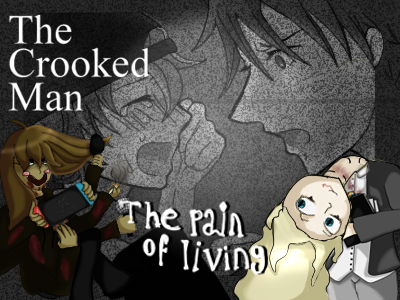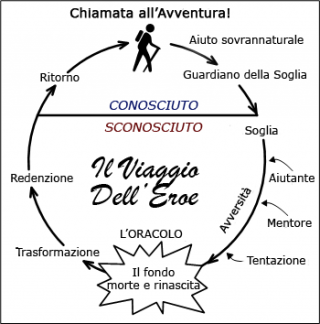Until now in this season of Back to the Future you have been able to appreciate with us the three great phenomena that would have helped to form the current Horror RPG for many elements, the so-called three “masters”: Ib, The Witch’s House and finally Mad Father.
In these games there has always been a common topic: the attempt to reach a more commercial language, the attempt to arrive to the general public and who knows, also have success and go higher, also with other media.
Ib with its “delayed” narrative, The Witch’s House with its light novel, Mad Father … With the whole game. But as anticipated in the article on sen’s title, we now have a return to the past, a title that made its fortune even if it was “released in the wrong generation”, an alternative to the dramatization given by the three RPG masters …
…Its name was The Crooked Man.
NOTE: In this article we will talk about the first version of The Crooked Man, the one that many players know and that reflects more than others the original spirit of the game. We will not take into account version 4, nor the Steam version.
Product History
“There was a crooked man walking on a crooked road” …
Okay, yes, you understand. But I tell you, I’m not quoting this historic nursery rhyme to talk about the game that currently uses it, we will talk about that in the paragraph of the Trump CArd and in the paragraphs dedicated to the Professionality Meter.
I would like to mention the “crooked” theme, because of my time spent on Google looking for as much information as possible, also in Japanese (bless automatic translators!) On the production history of this title: a forum where it was published for the first time, some kind of information about the production background…
Nothing, not even Uri’s Twitter profile tells me anything about this topic. I know she has a very nice dog, but I didn’t find anything relevant on the production history of the first Strange Man Series title.
Just to find out that the game came out in 2012 (we don’t even know on what month it was released!) I literally spent my time… To crook my back on the computer.
PaoGun is infecting me with bad jokes, huh?
Collecting the few info we have we can only take note of various updates to the game up to the so-called version 4, with some added music (we will talk more about it in the Ace in the Sleeve of this choice) and a few other things, together with the Steam version… That PLAYISM, the same PLAYISM that arrogantly took custody of Yume Nikki and the Mad Father remake, distributed without making too substantial changes to the most recent free version of the game, adding only Steam archievements and few other things. No comment.
Okay … So, given the limited amount of sources, we will skip the step of the first release of the game in its homeland and West, together with its peculiarities.
How was this title received by the public? For answering this question, the author’s twitter profile was helpful in summing up what led this title to being one of the masterpieces of the HOR-RPG.

The comment below, under Markiplier’s video, refers to the situation experienced by David’s mother in the game, introduced during the first scenes.

Okay, already from these two comments we can see that from the narrative point of view Uri has centered one thing: the themes and how much people can relate to them.
In the Ace In the Sleeve paragraph we will talk better about why the way some topics were covered in the game has affected so many people, let’s say for now that the staging has done its part.
But now let’s go to a reason much more “light” and suitable for the horror genre, namely the jumpscares.
![]()
![]()
When did we hear about jumpscare scaryness last time?
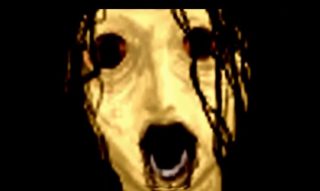

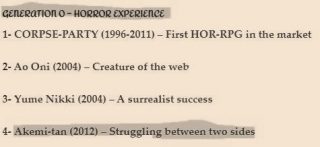
These three images say more than a thousand words.
Here we go to the speech said in the introduction: The Crooked Man was an isolated case of returning to the older generation of Horror RPG games. Even the gameplay of this title is in fact strongly based on pure exploration: although the story is very linear, we have the kind of gameplay that one would expect, in fact, from Akemi Tan, with the same types of strengths and weaknesses.
Having said that: so in detail, how an “old” title as this has paved its way on the generation of stardoms?
First of all there is one thing to consider: we can realize how Mad Father has built higher expectations regarding the narrative aspect of the RPG Horror.
And this in fact can be called a title with a very precise storyline, focused on an adventure that is nothing more than a metaphor for his inner journey.
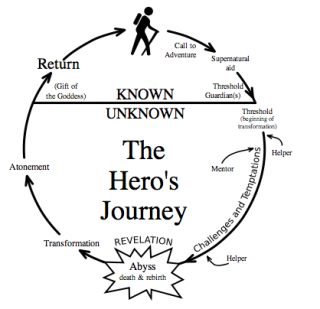
The hero’s journey is a very old narrative scheme, it is possible to trace it in numerous works of fiction. The characteristics that distinguish it were analyzed and collected later between the 70s and 80s.
We have a call to adventure, namely a succession of phenomena that convince the main character, the hero, to abandon their ordinary world to embark on an adventure in an extraordinary, unknown world.
During the journey, which may include several stages, the hero encounters obstacles (in our case the crooked man), and helpers. Maybe Sissi, D and Fluffy will not be real helpers, but they are certainly allies who contribute to David’s personal growth.
So here we are at the critical point of the development preceded or succeeded by a revelation (all the memories of David will lead him more and more to identify with the figure of the Crooked Man) which is followed by the achievement of an awareness that leads the character to a transformation , it doesn’t matter if this is positive or negative. So the story ends, the hero returns home and can be said to be ready for a new trip.
As you can see it is a scheme that can be used in a very versatile way: fairy tale (the closest genre as well as the most transparent on the allegorical level: prince-sorcerer-defeats the dragon-free the princess), adventure-fantastic, dramatic work ( as we will see, for example, for this title), fantasy (see Frodo’s call to adventure, in The Lord of the Rings), and can narrate the most varied themes.
Well, Uri decided to adopt this scheme to talk about depression (or to give an interpretation of it, at least) on which she built a very precise and linear dramaturgical discourse to which she proposed her creative solution in the ending.
In any case it is an aspect on which we will not insist further, also because, a small note: this game is mainly focused on an awareness of the main character; the places explored and the events that follow one another have to do with a very internalized and personal reality: being this the generation of Character Drama and not being able to have deep insights into the contexts and the environments chosen, we preferred not to dwell more on the pattern narrative that in itself is nothing new: it is only very interesting that it has been exploited and also very well for a horror title, reconciling the journey (even physical, concrete) of our hero, in fact, and exploration which is the main feature of the HOR-RPG genre.
Well … Let’s move on to the main topic of this analysis. The style of representation.
Mario Alicata and Giuseppe De Santis in 1941 in the magazine “Cinema”, pushed to:
“Bring the camera on the streets, in the fields, in the ports, in the factories of our country to make our best film following the slow and tired step of the worker who returns to his home”
Stop! Don’t go away!
We will not mention other boring books on cinema or explain phenomena of the 60s to say what made The Crooked Man unique: you are still in my (Ele) hands, guys, here we think about facts! There is a reason which is very close to the game that explains why my dear sister recommended me to put this quote in this article … In fact, we let her speak for a few lines. For now I only know that these words have to do with a precise current of Italian cinema of the 1940s and 1950s: the so-called Neorealism.
Here I am, then. Paogun. If you have no idea what I’m talking about I will try to explain it briefly. I am referring to a film current in particular that developed after the Second World War, mainly in Italy, which assumed some recurring characteristics such as dramatic stories and social and personal defeats, representation of cities and towns in rubble told through a camera more unstable, “close to the actors” and “grainy film”.
We know what you are thinking: on the one hand a very specific cinematographic current that refers to a specific historical period, on the other a game that first of all is a horror title, then of adventure and exploration, which tells of dramatic events.
… And yet, it is precisely in the stylistic choice that this game stands out.
Like the Neorealism current (which in any case has spread widely both in Europe and in the world) has characterized itself as something alternative to the glittering Hollywood comedies, so The Crooked Man darkens the hues, chooses more busy themes and dries up the dramatization in opposition the extravagance and the brighter colors of Mary’s sketchbook, of the gardens of Drevis House and Ellen’s house full of talking flowers.
I (Ele, I’m back!) Was able to connect and find similarities in terms of types of stories, characters and atmospheres with the writings of the literary current of Realism that studied in middle school.
In short: focus on the life of low-class people and write about their stories… With always a thin layer of heaviness in the atmosphere, for one reason or another: poverty, misunderstanding on the part of society, many times by the characters themselves which can be influenced by these factors or not, etc. etc.
Here, in this regard we take David’s character.
Mr. Hoover is definitely not a rich man: this is shown to us by the small and cheap apartment he could afford, with a… Bed in the kitchen-dining room-living room.
Throughout the whole game David with every sentence that is not a more complex system message will make us sigh with sadness. He himself sees himself perpetually as a wretch who does not detach himself from his previous mistakes and is above all a very compliant person.
This type of protagonist can make us assume an adventure full of joy.
But there is not only David and his attitudes to make us understand what this game communicates. We reiterate what we have mentioned before: the choice of style and the overall atmosphere that derives from it.
Let’s compare an interior and an exterior of Uri’s game with an interior and an exterior of its total opposite: Mad Father.
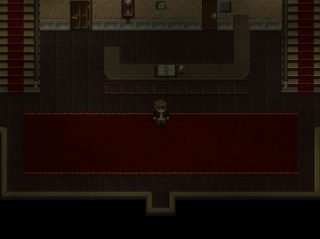
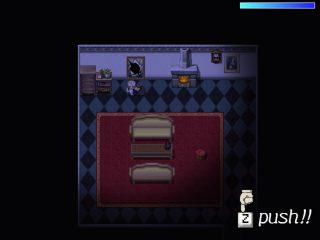
Remember: both games use Wolf RPG Editor and in both places it was evening or night.
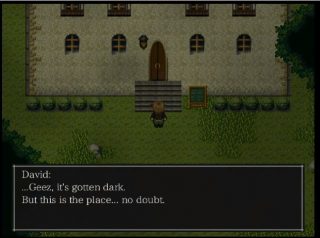
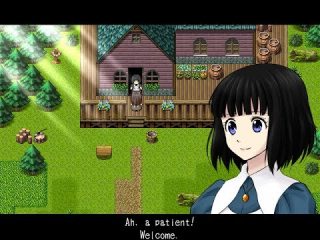
Even in these last two screens it is possible to see the huge difference in the management of the photography of the two games, even if the last image is in a daytime environment.
See how the colors of The Crooked Man are much less saturated?
It will seem strange to say, given that there are no particular lighting arrangements, but the very simple photograph of the maps of The Crooked Man communicates the heavy vibe of the game: abandoned places, a sad story of two sad men, surrounded by other characters with not too much… Crazyness, which are more anchored to reality than Mad Father’s ones, who had all sorts of oddities.
Also, continuing to talk about the atmosphere of The Crooked Man, apart from the cutscenes dedicated to the mother scenes of the game, during the gameplay there is no music.
At the beginning, I admit it, it seemed to me a choice that only made the game more boring, and at first friction I appreciated the choice of putting fixed music even during the gameplay in the 4th Version of the game, but continuing I realized that especially in the parts of abandoned places the lack of music in favor of loop ambience has a lot of effect, giving the sense of desolation that very respects the main genre of The Crooked Man, the horror genre.
Without forgetting how this choice makes certain cutscenes much more dramatic, to consider for example the initial scenes and the hospital one in particular.
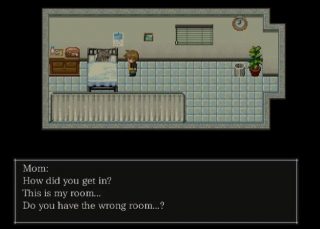
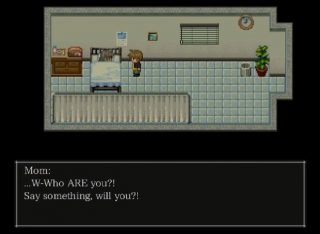
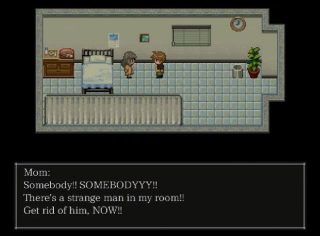
So, as in most of the titles of generation 0 The Crooked Man explores the abnormality in everyday life, but unlike the previous titles it chooses a very specific theme, exposing it in a defined storyline, while not giving up the taste of exploration and isolation that characterized “its ancestors”.
Professionality meter
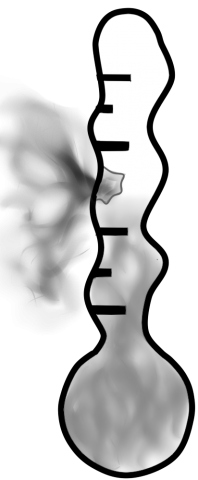
So. Yeah, the thermometer is more than half the height.
It is an excellent product, a story that is linear enough to be marketable even if it isn’t very accurate or strictly customized at the packaging level (for example, David’s sprite is not original, some parts of the UI remained the default ones and so on); moreover, it is the same style of the game and its very, very dry direction (we talked about it in the Trump Card) to reveal a double-edged sword as regards the binarism between “amateur game” and “professional game” which we are continuing to talk about.
Packaging
We mentioned something about the packaging of the game in the previous paragraph (about the “spartanity” of certain choices on the interfaces … Even the CGs, who want to adopt a “cinematographic framing” with numerous close-ups, have this defect), however is a game that has its style.
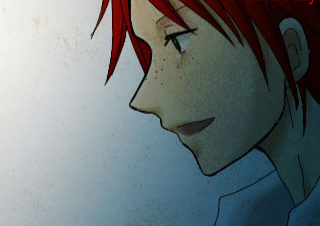 The title screen is in black and white with the monster on the side, it looks almost merged with the black background.
The title screen is in black and white with the monster on the side, it looks almost merged with the black background.
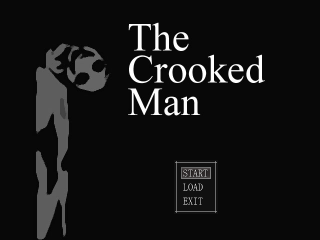
The image, the title, the nursery rhyme in the introduction: the game continues to promise us that we will see the story of a crooked man, so here it is presented in the next scene: David and his new home. We will discover the failures of his life as he runs away from the monster.
author-work relationship
So, to begin with this paragraph we could notice how Uri is a very present author for her games.
Uri’s updates, compared to those of other developers, are very recent and the last Tweet (as far as it is very much of “service”) on the Strange Man Series dates back to June 24: ten days ago! Do you remember the “author in mystery” discourse we made when we talked about Yume Nikki and other titles, together with how Kona5 broke this rule? We have a similar case.
Here, however, we have an addition: an ask-box.
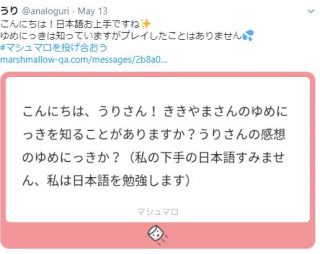
We have already seen in this section that Kona5 also responded (even in a less detached way) to the various comments on rpgmaker.net, but this contact with fans and with the work in Uri’s case is more visible.

(In this and in the previous photo you can see that Uri answers both in Japanese and in English)
Although the games are now a few years old, due to her constant updates (other titles that she is planning to make, questions, more personal posts… Her dog…), Uri has found fans that are still active today, which also years after the release of the various Strange Men Anthology titles (another name for the Strange Man Series) they still ask any kind of questions about the characters.

…Really, any kind of questions. I love the internet.
In addition, Uri in 2013 told the story of how The Crooked Man was born. We will not talk about it in detail, but in short it derives from an experience of the author’s brother.
Here’s the link of the english version, translated by VgPerson
Link for the japanese version, if anyone is interested
It was strange to find that behind such a dark and heavy game there is one of the most open to the public authors that we have seen in Back To The Future (also compared to Kona5, given that Uri is still active on Twitter, while Kona5 disappeared from the eyes of their potential public like many other authors), breaking that tradition that many authors analyzed in Back to the Future so far, relegated to the idea of ghost figures.
work defects
Linear narration… Gameplay with good, well-made ideas and also some original ones …
We don’t think The Crooked Man has… Particularly serious flaws.
I know, it is from The Witch’s house that we continue with this.
Let’s try to understand why.
The defects of this work refer mainly to specific sections of the game:
° The start, and therefore the introductory cutscene inherent in the presentation of the events because of its slowness (which the style of representation that The Crooked Man has chosen does not help to dispose of at all) and the numerous cutscenes before you could actually start playing.
° The ending. So yes, the ending, since it has completely distorted the characters that meet along the way because of a plot twist that betrays the dramatic-realistic nature of the game, relying too much on the supernatural and canceling any freedom of interpretation, especially for how the three (four, including David) characters were presented: real people with their real problems united by the persecution of the Crooked Man. It would have been much more impactful to see how much this issue is not relegated to a single individual, but it can involve each of us in our countless daily contexts.
Speaking of the end of the game, the final scenes (from the confrontation with Duke onwards) adopt only one register, the dramatic one. A whole other thing compared to the beginning, where the succession of cutscene, however slow, integrates more “genres”: it is true that we have the scene with the mother in the hospital with only the noise of the air conditioner, but the night at David hear strange noises and disturbing footsteps, and here we are catapulted into the horror genre… But without losing homogeneity in the predominant chosen atmosphere. It is not a very serious defect or that considerably ruins the work, it simply makes it lose part of its charm, and for this reason we wanted to analyze the ending of the game in this paragraph.
But the “greatest value” of these types of defects…
In addition to the minor ones like some logic problems that can be solved with some changes to the lines of dialogue:
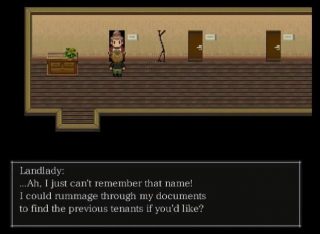
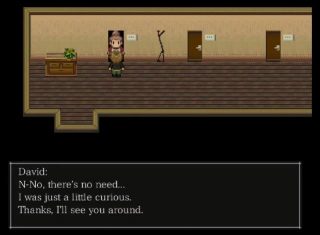
Why on earth did he refuse to have at least the name of the person he was looking for? In this case it would have been enough not to have any information about the mysterious man not even to the landlady, maybe she didn’t have his name on the documents for a reason or another, etc…
…Is that they are mainly divided into separate sections.
As you have read, we are talking about the beginning and end of the game. Not of the central development, not during the exploration of the abandoned places, so also David’s past, on which the heart of the title’s message focuses.
Small curiosity: around the web we happened to find conflicting opinions on David’s behavior towards the monster and any logic defects that would derive from unnatural reactions in his behavior.
Everyone can classify this defect in the level of gravity that they consider appropriate, for example we think it is a justifiable error because of the extremely “psychologized” reality that the work shows us (we talked about it in the Trump Card paragraph). So we can reconnect, for example his behaviors and almost “carelessness” towards the oddities that happen in his new home to his predominantly yielding attitude towards life. So here, in our opinion, his hesitation before embarking on the journey is also justified, without considering that in any case he tried at least to give an answer to the phenomena that happened (like when he calls Paul to ask for explanations on the writing on the mirror).
Conclusion
The Crooked Man was a title that surely left its mark in the period in which the HOR-RPG had become a fashion giving, with its peculiar style, the possibility for fans to be able to observe deeper and deeper facets in the games that with time were discovered on the web. The importance of treating this game in Back to the Future derives from showing the variety of styles and representations that these games had, while referring all to well-defined characteristics.
For us it was also certainly interesting to note how this game is perhaps unique and one of the few “survivors” of its kind, while in the meantime some other lover of the current already preferred to retire in the demented and parodic tones of Mogeko Castle.

